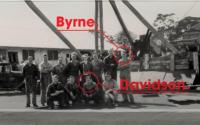A MASON’S INVENTION: ROLL-A-DOOR
24 June 24
Roll-A-Door: The garage gift
Arthur Byrne was the founder of B & D Roll-A-Door and the man who brought easy-opening garage doors to the world.
Many Australians of the 1950s and 1960s can still sing the company’s advertising song ‘Use a roll-a-door, that’s what it’s for’ to the tune of the ‘Toreador’ song from the opera Carmen. This was sung in the advertisements by Bro Alan Light.
In 1946 with his business partner Paul Davidson and ₤140, Byrne established a steel fabricating business. The partners built a factory in Botany, undertook large Engineering projects across Australia and recruited young accountant Ray Willoughby.
When the Sydney inventor Ben Saul walked into the B & D office with an idea for a door, Byrne gave him a workplace, tools and materials but after the first attempt, Saul lost interest and the materials were stored. Leaving the business, Saul signed away his rights to the door but Byrne and Davidson decided to give it another go.
Byrne put in many years work and Gordon Lambert, a boilermaker, refined a design before they met success with the first all-steel door that could be rolled and unrolled without cracking. It was made of compressed metal sheet fastened together, forming a flexible curtain that rolled around an axle and spring assembly.
The result was a safe, secure garage door that was easy to open. B & D introduced the slogan ‘Even a child can open it’.
The Roll-A-Door was unveiled at the Daily Mirror Home Show in 1956 and became a success. The company then set up a research and development program for continuous design improvement. Davidson resigned a year later and Willoughby became joint managing director.
In 1959, B & D invested in the Sydney market using the new medium of television to advertise its product. Then one night, sitting in his car in the driveway, Byrne pondered the idea of opening the garage door without leaving his vehicle. He worked on the idea of a light sensitive unit signalling the door to open and soon the automatic door was invented.
The company went national in the 1960s, opening a factory in Melbourne and by 1963, it was operating in the United States and Europe. Another breakthrough came with the development of Nylofelt in 1968 which made opening doors even easier as the shoelace-like Nylofelt that ran down either side allowed for greaseless quiet operation.
When Neil Armstrong walked on the moon in July 1968, B & D ran a television campaign featuring the astronauts discovering Roll-A-Door with a bemused Chips Rafferty behind it and greeting them with: ‘G’day mate, what kept ya’. By 1971, they introduced the Colourbond Door and in 1975 the automatic Controll-a-Door.
Arthur William Byrne was born and raised in Bondi and with his brother Leo was always on the lookout for ways to make money. They caught fish and sold them on the buses, then bought a horse and sold rides to local kids. Family stories say young Arthur dismantled his bicycle to make a golf buggy and later made a fibreglass swimming pool but could not convince manufacturers of its promise.
After a family member died from leukaemia in 1979 he created the Len Leukaemia Foundation which merged with the Jenny Trust in 1980 and is known today as Cure Cancer Australia. At a gala dinner in 2005, Byrne proudly announced that more than $10 million had been raised for research into cancer since 1979.
Arthur William Byrne was initiated, passed and raised in 1948 in Lodge Booralee Lewis No 598 in Sydney while Leo Byrne was initiated in Lodge Empire Temperance No 432 in 1955
 .
.
As appeared in the FREEMASON DECEMBER 2010


